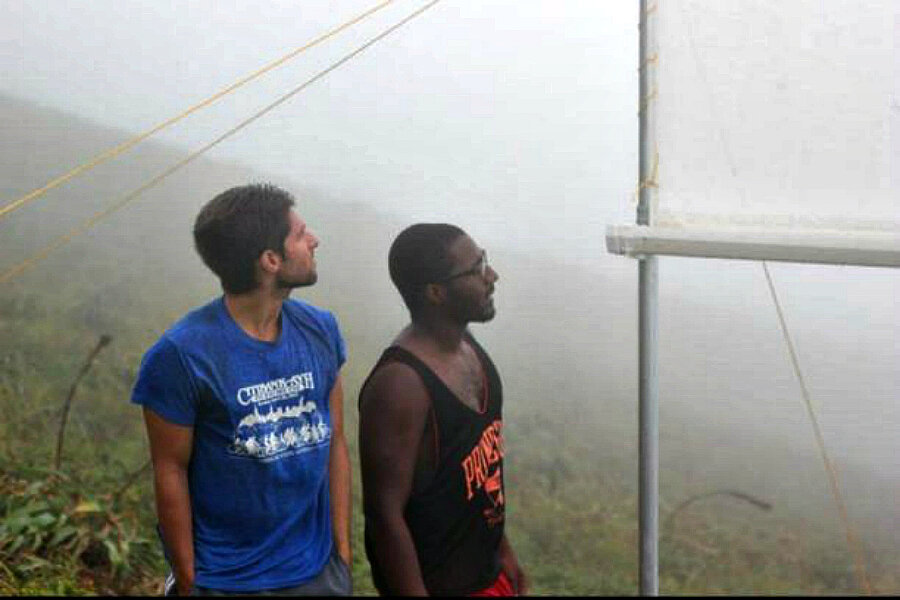Out of the fog: how a startup harvests water from thin air
Loading...
[This article first appeared on TruthAtlas.com. TruthAtlas is an online news source featuring multimedia stories about people and ideas making the world a better place. Learn more at www.truthatlas.com.]
With ongoing climate change and contaminated groundwater causing major rifts in water sustainability, nations are beginning to look into alternative water solutions. One startup, PHOG Water, has prototyped a net, based on ancient technology first crafted by the Incas, that harvests water from fog.
When Michael, Andrea, and Jeremy told the locals in Saint Vincent and the Grenadines that they were climbing to the top of the volcano La Soufrière, located on the island of Saint Vincent, they were met with incredulity and the idea was basically dismissed as crazy. The peak of La Soufrière tops off at 4,049 ft. And then they told them they were actually doing it twice in one week; all for the pursuit of fog.
Michael Thomas, Jeremy Blair, and Andrea Bühler, the team now known as Phog Water, are on a mission to harvest clean drinking water from thin air. And as it turns out, La Soufrière has the perfect conditions: heavy winds, high elevation, and low-lying clouds. Harvesting water from fog requires low-tech nets that essentially capture the water. Suspended water droplets in the air come into contact with the net, coalesce into larger droplets, and then run into a collection trough. The water can then be collected or piped back into town.
It isn’t a new technique. Similar techniques date back to the Incas. But it wasn’t until 1987 that researchers began to look into ways to tweak the technology and make it effective in different, slightly nuanced environments. FogQuest, a Canadian based charity, paved the way for PHOG Water, and today the charity maintains nets in Morocco, Nepal, Chile, Ethiopia and Guatemala. Still, even despite the fact that the technology is nearly self-sustainable and requires very little energy and upfront investment (compared to harvesting ground water), there are still foggy peaks around the world, waiting to be tapped into.
“We’ve developed our own prototype for the net and our own system. The technology is very site specific,” Michael explained. Still, with the prototype, the team can make tweaks to create the most effective net in any given location, provided that the basic climate conditions are right.
Michael and Jeremy first came across cloud-harvesting technology in a Princeton University entrepreneurship class. They created an early version of the PHOG Water business plan for their final project, and Andrea would soon join the team. Michael, who was born in the Grenadines but grew up in New York, knew immediately that the Grenadines would be ideal for harvesting fog water.
So last summer, the team walked up La Soufrière, with a hunch and a net; but not much more. When they returned to the site at the end of the week, they had so much water that their troughs were overflowing. They had gathered more water than they’d even anticipated. Michael estimates that one net can produce about 1 million liters (264,000 gallons) of water in a year.
At the end of August, the team will return to La Soufrière to set up more nets. They are hoping to raise $10,000 through their crowd-funding campaign, enough to install and maintain three nets. PHOG Water plans to hire locals to maintain the nets during the year, though they require very little maintenance. “They’re very low energy,” Andrea said. “And each net has a 15-year life span.”
While PHOG Water may still be at the forefront of the technology (drinking water still comes primarily from fresh streams and groundwater), water sustainability is something nations are beginning to take seriously.
“Water’s at the age where people are beginning to think about the future with climate change and clean water access,” Michael said. With global warming making climates more precarious, regions know they have to begin looking for more ways to access clean drinking water and sustain their community.
While the water situation in Saint Vincent and the Grenadines is relatively good, the nation experienced a drought just this year, for the first time in years. It’s something that may be even more detrimental to water-rich areas since they didn’t have a reason to prepare for an arid season.
PHOG Water has also started looking into areas in the United States, setting their sights on northern California.
“After the drought in California, we realized the technology would help to secure our water, but also secure our agricultural needs, securing our food as well,” said Michael.
Water is the most essential resource for sustaining human life, and its veritable trickle-down effect can completely transform a community’s entire well-being.
PHOG Water hopes to eventually push their technology around the globe. They are on the hunt for foggy peaks, and they they’re soliciting ideas through social media. They want to drive an awareness and inspire others to set up their own nets. Their long-term goal is to create a sustainable, environmentally friendly bottled water brand.
• To help PHOG Water fund a net in Saint Vincent and the Grenadines, visit here.
• Michelle Burwell is a Chicago based journalist and fiction writer. She works as a copywriter for Joint Loyalty, a Chicago loyalty card start-up. She’s also a freelance journalist for 1776D.C.’s Challenge Cup, a global tour to find the most transformative start-ups. Michelle obtained a B.A. in Journalism and Political Science from Miami University Ohio. When she’s not writing, Michelle enjoys traveling, thrifting, and live music. Learn more about Michelle here.







